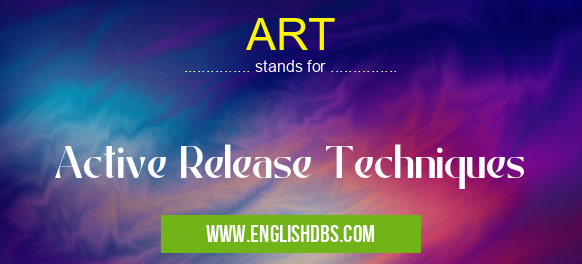What does ART mean in UNCLASSIFIED
Active Release Techniques (ART) is a soft tissue, hands-on treatment technique used by healthcare professionals such as chiropractors and physical therapists to help relieve pain and improve muscle function. ART helps restore normal movement and function of the soft tissues in the body with the use of specific manual manipulations. The technique involves applying pressure to myofascial trigger points, which are tender areas on the body that have been contracted or stretched beyond their normal range of motion. By applying pressure on these areas, soft tissue can be released restoring flexibility and allowing for longer lasting effects than other forms of therapy.

ART meaning in Unclassified in Miscellaneous
ART mostly used in an acronym Unclassified in Category Miscellaneous that means Active Release Techniques
Shorthand: ART,
Full Form: Active Release Techniques
For more information of "Active Release Techniques", see the section below.
Benefits of ART
The benefits of Active Release Technique (ART) include improved range of motion, relief from pain due to muscular imbalances or restrictions in joints or tendons, improved posture through corrected active/passive muscle balances within the body’s kinetic chain, improved coordination and stability while increasing strength & power production potential with sport-specific movements/activities. Additionally it can help relieve headaches caused by neck tension & stiffness or jaw dysfunction; assist in active rehabilitation following surgery; correct foot alignment issues related to plantar fasciitis; and assist with digestion issues due to abdominal wall restriction.
Essential Questions and Answers on Active Release Techniques in "MISCELLANEOUS»UNFILED"
What is Active Release Techniques?
Active Release Techniques, or ART, is an advanced technique used by trained clinicians to assess and treat soft tissue injuries. It helps alleviate pain and restore normal mobility and strength by using massage-like techniques to resolve tightness and tension in the body's soft tissues.
How Does ART Work?
ART works by manually breaking down adhesions or scar tissue that has built up in the soft tissues due to overuse, trauma, or stress. This process of revitalizing the tissue enhances recovery time and decreases pain levels so that patients can return to their activities more quickly with increased strength and flexibility.
What Conditions Can Be Treated With ART?
ART can be used to effectively treat a range of conditions including chronic back and neck pain, rotator cuff tendonitis, carpal tunnel syndrome, tennis elbow, shin splints, achilles tendonitis, plantar fasciitis, shoulder impingement syndrome, runner’s knee and hamstring strains.
How Long Does An ART Treatment Take?
Depending on the severity of your condition and other factors such as age or general medical history, each treatment session typically lasts between 20 minutes to 45 minutes. Multiple treatments may be needed for optimal results depending on the individual case.
Is There Any Pain Associated With ART?
During the treatment you may experience some discomfort as your therapist applies pressure to areas of tightness or restriction in order to break up scar tissue adhesions. However this is not always painful – it all depends on how sensitive your particular area is as well as how severe your condition is. Generally speaking though it should feel like a stretching sensation rather than intense pain.
Does Insurance Typically Cover ART Treatments?
Generally speaking most major insurance companies cover some portion of an Active Release Technique treatment depending on your unique policy provisions. You will need to check with your insurer to determine whether they cover any portion of these visits before booking an appointment.
Are There Any Risks Or Side-Effects Associated With An ART Treatment?
Most side effects associated with an Active Release Technique are minor in nature such as mild soreness for several days after a treatment session; however these typically subside within 48 hours. As with any type of massage therapy there are potential risks involved depending on certain pre-existing health conditions which should always be discussed prior to starting any treatments.
Do I Need To Follow Up On My Treatment After An Appointment?
In order for best results following up with physical therapy or chiropractic care is recommended after each treatment session in order to create a comprehensive plan for recovery from injury or chronic pain management issues.
Is There Anything I Should Avoid Doing Before Having An ART Treatment?
Before having an Active Release Technique session you should avoid eating at least two hours beforehand as well as drinking alcohol up 12 hours prior – this will ensure that there are no problems during the massage due to low blood sugar levels.
Final Words:
Active Release Techniques (ART) is an effective soft tissue treatment technique primarily used for treating sports injuries as well as conditions caused by repetitive injury such as carpal tunnel syndrome or plantar fasciitis. By manipulating muscles beneath your skin through deep pressure massage it helps break up muscular adhesions providing immediate relief from chronic pain conditions while also helping improve mobility & flexibility in muscles & connective tissues affected by injuries. It can also assist with many other conditions such as headaches caused by neck tension/stiffness & even aid digestion due to abdominal wall restriction making it extremely versatile in its application.
ART also stands for: |
|
| All stands for ART |
